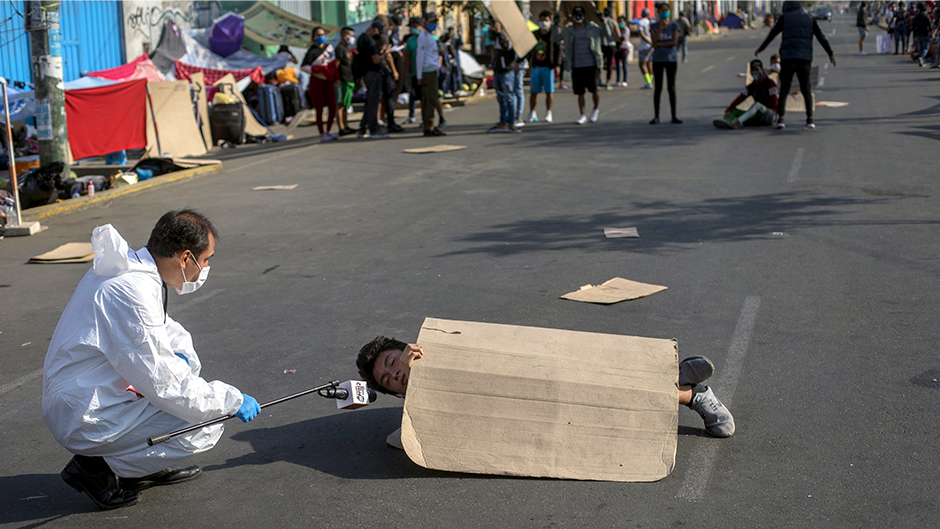In the fight against the coronavirus, some frontline workers have not been highlighted.
These are the journalists who face the risk of getting the disease in order to inform the public. Many of them are now paying the highest price.
About 127 journalists have died in 31 countries from COVID-19, according to reports compiled by the Geneva-based Press Emblem Campaign.
“We need to recognize the risks our journalists face in doing their essential work, investigating the causes and implications of health conditions and policies that impact health, as well as the experiences of oppression and avenues for resolution,” said Karin Wilkins, dean of the School of Communication.
Of all the continents, Latin America is the most affected with at least 62 journalists who have died from the virus, compared with Europe's 23 victims, Asia's 17, North America's 13, and Africa's 12. The Poynter Institute in Saint Petersburg, Florida, has collected remembrances of 12 working and retired journalists who have succumbed to coronavirus in the United States.
Of all the Latin American countries in the study, Peru has the highest number of journalists who have died from the virus. Twenty have died in the past two and a half months. Six of the journalists died in the area of Iquitos, an indigenous region in the northern Amazon region of Peru that saw one of the biggest outbreaks.
Peru has reported 5,738 deaths due to the coronavirus, the third highest in the region after Brazil and Mexico, according to the country’s health ministry.
Sallie Hughes, associate professor in the School of Communication and faculty director at the Institute for Advanced Study of the Americas, said that journalists are trained to “go get the story” and only in recent years has the issue of minimizing risks while on assignment caused journalists to take potential dangers more seriously.
“The default mindset of a journalist is: ‘I am going to cover the hurricane. I am going to the scene of a horrific shooting or accident, and I am going to do it because it is my job and because it is important to inform my readers, my community,’” she said.
More journalism associations, international rights organizations, and academics are demanding journalists be provided safety training before covering risky stories and be offered psychological debriefings afterward, Hughes said.
In the case of the Latin American journalists, besides access to training, other factors come into play that put them at a higher risk of infection. This includes a lack of financial resources, which prevented many from getting the appropriate gear to protect themselves, she explained.
“In Latin America, as in the U.S., there is a hierarchy in news organizations,” she said. “Some of the Latin American news organizations are well resourced and can provide journalists with training and appropriate protective gear, while many others are not able to do so.”
Another factor affecting many Latin American journalists is the precarious labor conditions they work in, Hughes noted. Many are freelancers who rely on their own initiative and news savvy to survive. They are paid by the piece and often not a very high wage. Staying home in quarantine is not an option for them.
“They have to work,” Hughes said. “They have to cover the hospital. They have to go to the morgue and speak to the victim’s family, because that is the story they can sell.”
All these stories are vital for an informed society during a health crisis, even more so in locations where governments may not be forthcoming or are even downplaying the severity of the crisis, she pointed out.
Hughes’ research partner at the University of Lima, Professor Lilian Kanashiro, explained that all of these conditions have increased the risk of infection for Peruvian journalists, with the additional factor being that the worst hit parts of the country are areas where government health services are absent or poorly financed.
“In the case of the Amazon jungle, it is a double vulnerability,” Kanashiro said. “The health system had already been hit by dengue and by the indifference of the central government. After dengue, COVID arrived and the blow was brutal.”
Journalists in other continents have also succumbed to the virus.
Zororo Makamba, a broadcast journalist in Zimbabwe, died of the coronavirus on March 29. He was 30 years old and Zimbabwe’s first coronavirus death.
Writing in The Herald, the state-owned daily newspaper, Leroy Dzenga described Makamba as “a passionate, eloquent patriot who understood the role of lucid communication in nation-building.”
In Italy, Paolo Micai, a journalist and camera man, died in March. The Italian news website wrote about him. “In the last month he had narrated the drama of COVID-19 in the front line, accompanying with his images the stories of journalists from the cities and countries most affected by the pandemic,” it stated.
In the U.S., Maria Mercader, a journalist with the CBS News, died of the coronavirus. She was 54 years old. CBS News reported: “Maria got her start at CBS News in 1987, in the CBS Page Program. In her years working on the CBS News foreign and national desks, Maria helped produce many of the biggest stories, including the death of Princess Diana and the 9/11 attacks. She won a Business Emmy in 2004 for her work on a CBS Sunday Morning report on computer spam.”
“During this pandemic, the danger for journalists globally are far more widespread than ever before,” Hughes remarked. “And in the end, journalists, especially photographers, are frontline workers and face some of the same risks as health workers, emergency service workers, and others.”

